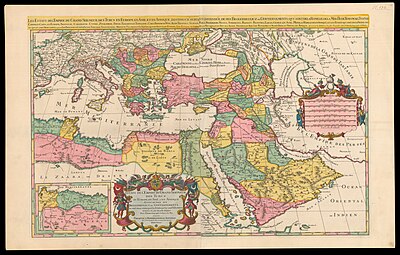
Back إيالة عثمانية Arabic ايالة عثمانيه ARZ Еялет Bulgarian এয়ালেত Bengali/Bangla Pašaluk BS Eyalat Catalan ئێلایەت CKB Ejálet Czech Ejalet Danish Eyâlet German

Eyalets (Ottoman Turkish: ایالت, pronounced [ejaːˈlet], lit. 'province'), also known as beylerbeyliks[1] or pashaliks, were the primary administrative divisions of the Ottoman Empire.
From 1453 to the beginning of the nineteenth century the Ottoman local government was loosely structured.[2] The empire was at first divided into states called eyalets, presided over by a beylerbey (title equivalent to duke in Turkish and Amir al Umara in Arabic) of three tails (feathers borne on a state officer's ceremonial staff).[2] The grand vizier was responsible for nominating all the high officers of state, both in the capital and the states.[2] Between 1861 and 1866, these eyalets were abolished, and the territory was divided for administrative purposes into vilayets (provinces).[2]
The eyalets were subdivided into districts called livas or sanjaks,[3] each of which was under the charge of a pasha of one tail, with the title of mira-lira, or sanjak-bey.[4] These provinces were usually called pashaliks by Europeans.[4] The pasha was invested with powers of absolute government within his province, being the chief of both the military and financial departments, as well as police and criminal justice.[4]

At official functions, the order of precedence was Egypt, Baghdad, Abyssinia, Buda, Anatolia, "Mera'ish", and the Kapudan Pasha in Asia and Buda, Egypt, Abyssinia, Baghdad, and Rumelia in Europe, with the remainder arranged according to the chronological order of their conquest.[5]
- ^ Özbaran, Salih; Lyma, Dom Manuell de (1972). "The Ottoman Turks and the Portuguese in the Persian Gulf, 1534 - 1581". Journal of Asian History. 6 (1): 52, 55. ISSN 0021-910X. JSTOR 41929749.
- ^ a b c d A handbook of Asia Minor. Naval Staff. Intelligence Department. 1919. p. 203.
- ^ Raymond Detrez; Barbara Segaert (2008-01-01). Europe and the historical legacies in the Balkans. Peter Lang. p. 167. ISBN 978-90-5201-374-9. Retrieved 2013-06-01.
- ^ a b c The empires and cities of Asia (1873) by Forbes, A. Gruar. Page 188
- ^ Çelebi, Evliya. Trans. by von Hammer, Joseph. Narrative of travels in Europe, Asia, and Africa in the seventeenth century, Vol. 1, p. 90 ff. Parbury, Allen, & Co. (London), 1834.